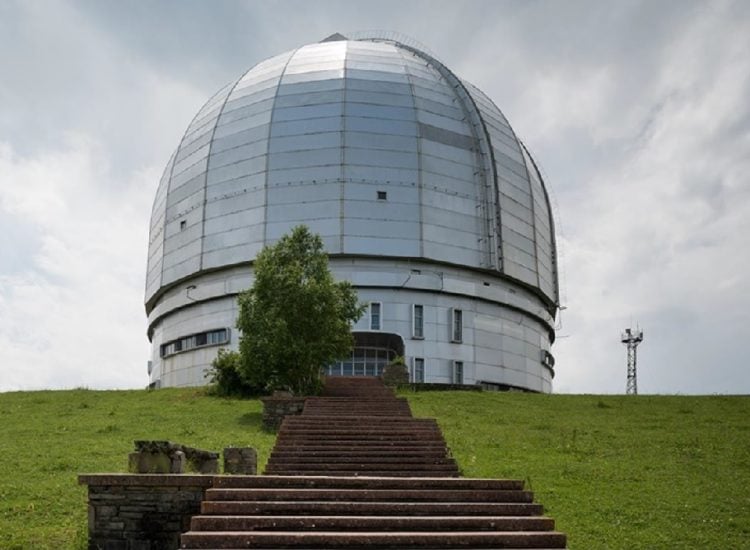Unless you’re a very well-read Cold War geek—or an astrophysicist—chances are you’ve never heard of the observatory in the republic of Karachay-Cherkessia, in southern Russia. The site, built on a mountain in North Caucasus in 1966, is celebrating its 50th anniversary this year, but its conceptual origins dates back to the 1930s, when the Soviet Union set out to build the largest planetary observatory in the world.
Equipped with a telescope that can capture images 14 billion light years away, effectively “seeing” the edges of our universe (and still emblazoned with the abbreviation CCCP today), the observatory was indeed the biggest, for about 20 years, until the 1990s. To mark its anniversary, the active observatory and the adjacent scientific campus, which houses some 1,000 inhabitants, became the host for an ambitious art show earlier this month, titled “The Observatory.”
It’s an Austrian-Russian collaboration, thought up by Simon Mraz, former Dorotheum auctioneer and Austria’s powerhouse Director of the Austrian Cultural Forum in Moscow, together with Mariana Guber-Gogova, founder of the Gogova Foundation, her twin sister, Madina Gogova, who’s the permanent representative of the Karachay-Cherkess Republic at the President of the Russian Federation, and curator Andreas Krištof of Section A Wien, Vienna.
Madina and Mariana Gogova. Photo by Anastasia Lebedeva.
The participating artists—a list of 10 young and adventurous Austrian and Russian names—traveled to the scientific campus in Nizhny Arkhyz about a month ahead of the opening to produce works on site, working with the local community, which is mostly made up of astrophysicists. During the opening, locals commented on the clash between the two approaches, scientific versus artistic, but also the similarities between them.
Following the opening event, with its invited press and guests of the Austrian embassy, not a lot of viewers outside the campus are going to see the show, so it seems imperative that the locals “get” it.
What’s certain is that the idea of a day job that consists of exploring the outer edges of the universe sparked artists’ imaginations just as much as the Soviet-era scientific campus with its run-down functionalism, and the picturesque rural landscape of the North Caucasus mountain ridge, dotted with ancient churches, did.
In her work A Thousand Trifles (2016), Svetlana Shuvaeva added slight interventions—imperceptible at first—into the domed white space of a congress hall. A door that leads nowhere, an electricity outlet made of paper, with a faux cable and cellphone attached. The window seems to have too many panels, and outside, all the cars in the parking lot bear the same license plate. It’s a shrine to the tricks our minds play on us, and to its polar opposite: making sense of inexplicable phenomena.
Dealing with a more obvious presence, Yuri Palmin, Russia’s most successful architectural photographer (and the most recognizable name on the roster), staged a show inside a defunct local grocery store, shifting the focus to the decaying concrete structures that make up the local scientists’ village. When your everyday business involves concepts spanning 14 billion light years, what do the remnants of architectural styles and shattered social systems dating back only 100 years mean to you?
Taking another leap in time, artist Alexandra Paperno installed her work in a nearby temple from the middle ages, outside the campus in Nizhny Arkhyz. There, she is showing painted wooden panels that depict discarded constellations not recognized by the International Astronomical Union, which, in 1922, adopted a list of 88 constellations for the southern skies. Abolishing all others, it is not accepting any new ones either. Paperno culled some 50 such abolished constellations—many stemming from old maps by the Greco-Egyptian astronomer Ptolemy—and combined them into a vast, multi-panel artwork. It speaks of the grandness of man’s inquisitive mind, just as it attests to the pettiness of his arbitrary bureaucratic systems.
Alexandra Paperno, Abolished Constellations, (2016). Photo by Yuri Palmin.
Another highlight in the exhibition—varied and rich as it was—included works installed within the observatory itself, leading to the massive telescope. Austrian artist Eva Engelbert created the wall mounted piece Space emblem for G.B., (2016), inspired by the work of Galina Balashova, the woman behind the “corporate identity” of the Soviet space program, and all its design elements.
Artist Michail Michailov showed a video projected on a drawing which he positioned on the floor, in the telescope’s control room. Titled M-theory, it shows the artist filmed from above, wearing a traditional Caucasian wool hat and performing a Cherkessian folk dance. The drawing on which it is projected, and which rotates on the ground, depicts dust and hair collected from the artist’s studio. In a site dedicated to the biggest questions about existence, Mikhailov attempts to grasp human subjectivity and the smaller existential questions that moor it.
“The Observatory” is on view in the Astrophysical Observatory of the Russian Academy of Science in Nizhny Arkhyz, Karachay-Cherkess Republic, Russia, from October 16–November 5, 2016.
